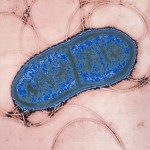Link to Pubmed [PMID] – 22079134
Curr. Opin. Immunol. 2012 Feb;24(1):15-20
Bacteria are constantly challenged by bacteriophages (viruses that infect bacteria), the most abundant microorganism on earth. Bacteria have evolved a variety of immunity mechanisms to resist bacteriophage infection. In response, bacteriophages can evolve counter-resistance mechanisms and launch a ‘virus versus host’ evolutionary arms race. In this context, rapid evolution is fundamental for the survival of the bacterial cell. Programmed genetic variation mechanisms at loci involved in immunity against bacteriophages generate diversity at a much faster rate than random point mutation and enable bacteria to quickly adapt and repel infection. Diversity-generating retroelements (DGRs) and phase variation mechanisms enhance the generic (innate) immune response against bacteriophages. On the other hand, the integration of small bacteriophage sequences in CRISPR loci provide bacteria with a virus-specific and sequence-specific adaptive immune response. Therefore, although using different molecular mechanisms, both prokaryotes and higher organisms rely on programmed genetic variation to increase genetic diversity and fight rapidly evolving infectious agents.

